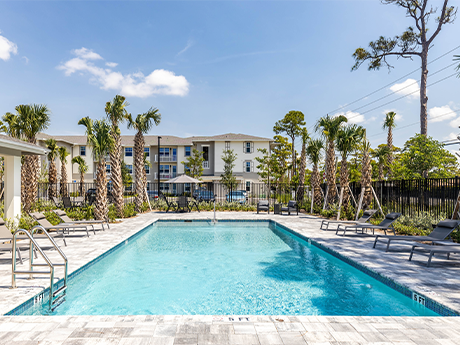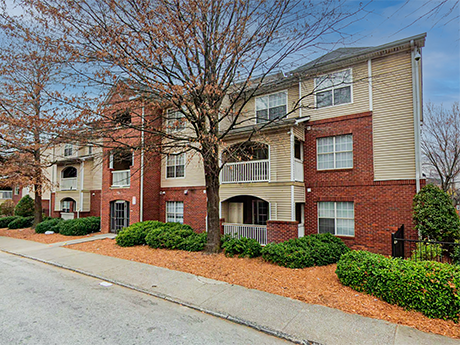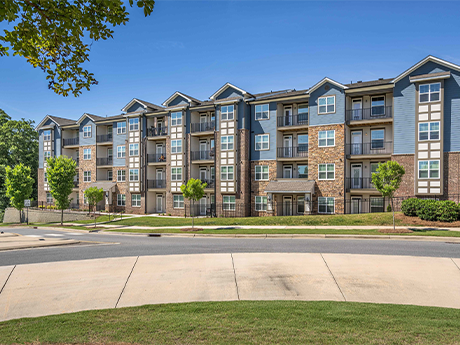The multifamily investment market has provided some mixed signals over the past year. There have been the ebbs and flows in the 10-year U.S. Treasury bond yield and interest rates, a moderating level of inflation (the Consumer Price Index rose 2.7 percent in November on an annual basis), and a hard-fought presidential election with Donald Trump emerging as the victor.
Despite the volatility in the debt markets, the overall sentiment among investors remains positive.
CoStar Group notes that multifamily transaction volume nationally rose 18 percent year over year in the third quarter of 2024, reaching $74 billion. CoStar adds, however, that momentum noticeably slowed toward the end of the quarter, when fixed-rate borrowing costs climbed in step with the rising yield on the 10-year U.S. Treasury note.
“This trend is underscored by a 4 percent decline in quarter-over-quarter transaction volume — a contrast to the typical seasonal uptick in the third quarter — following stronger activity in the first two months of [the fall season],” says Chad Littell, national director of U.S. capital markets analytics at CoStar.
A ‘Pickup’ in Transactions
Littell observed that the U.S. multifamily investment market “somewhat mirrored” the movement of the 10-year U.S. Treasury yield, both surging and retreating as the yield fluctuated around the 4 percent threshold.
“Each dip below 4 percent signaled the possibility of even lower rates ahead, sparking bursts of activity,” explains Littell. “However, since the Federal Reserve began cutting its policy rate in September, the 10-year yield has moved significantly higher, dampening the velocity of fixed-rate debt originations.”
The 10-year Treasury yield registered about 4.5 percent at the close of business on Dec. 18.
The end of the year and the election of a pro-business president have given deal volume a boost, adds Nicole Churchill, managing director of real estate at Greystar.
“We are seeing a pickup in transactions in the fourth quarter,” she says. “Owners are actively preparing to market in 2025, and investors are hungry to acquire.”
Dan Spiegel, senior vice president and managing director of Coldwell Banker Commercial, is heartened by the level of multifamily investment activity this year, especially when compared with 2023.
“Lending has been more resilient and active than we would have expected during this same period last year,” he notes.
Walker & Dunlop can confirm that volume is also increasing for its firm. The real estate finance and advisory services provider has experienced a 10 percent increase in transaction volume year to date. Todd Stofflet, managing director of investment sales in the firm’s Chicago office, thinks he knows why.
“Conviction in placing capital into the U.S. housing market remains strong,” he explains. “Many executives through recent earnings calls have signaled the bottom of commercial real estate having occurred in the back half of 2023. Walker & Dunlop’s 2024 increase in sales is driven by healthy amounts of dry powder pursuing multifamily acquisitions.”
Stofflet believes strong fundraising efforts, particularly among large closed-end funds in recent years, have equipped these major investors with substantial dry powder. Two of their main targets have been large portfolio acquisitions and high-quality assets purchased during a period of dislocation, offering attractive entry points that allow these investors to achieve higher targeted returns.
“These investors are eagerly acquiring assets at strong discounts to replacement cost in markets with favorable long-term fundamentals,” he explains. “With the sharp rise in interest rates, construction starts began to fall. This allowed investors to underwrite more robust rent growth outside of the delivery wave, given the undersupply of housing that exists across the country.”
Littell adds that multifamily absorption has remained historically strong, even as the current supply wave nears its final stages.
“This stability has shielded many properties from operational challenges and keeps high-quality multifamily in demand,” he says. “A significant number of assets have experienced healthy price appreciation over the past five years, leaving many owners in a solid financial position with strong occupancies.”

Captive Renters
The same is not true for most Americans, whose financial positions exclude them from home ownership.
“The continued lack of affordability provides high barriers to entry on the for-sale side of the housing market,” adds Stofflet. “Affordability remains near all-time lows, making renting a more favorable choice. With over half of [homeowning] Americans locked into sub-4 percent mortgage rates, it is not difficult to see why there is a lack of for-sale inventory.”
Still, high interest rates can hamper the success of some of today’s multifamily investments, cautions Littell.
“There will be instances where solid price growth through 2022 wasn’t enough,” he says. “The combination of a property’s capital structure and today’s borrowing costs relative to a few years ago can make a successful exit unattainable for a particular cohort of borrowers.”
One of those cohorts may be investors with nonrecourse loans. Spiegel notes there are a number of these multifamily borrowers with properties that are underwater with cash flow that are either going into, or are currently in, foreclosure.
“Although the Fed has reduced rates, mortgage interest rates remain high,” he explains. “If they stay high, we will have additional distressed assets.”
Valuations Reset
The current interest rate environment has also led to a notable recalibration of asset pricing, says Jon Trott, co-chief investment officer of Richmond, Virginia-headquartered Capital Square. Today’s relatively high level of interest rate volatility creates additional challenges when it comes to valuing and pricing assets for both equity and debt investors.
The result is rising cap rates, investors who demand higher risk premiums and, oftentimes, a wide bid-ask gap.
“Sellers are hesitant to sell in a depressed market, while buyers face challenges from higher borrowing costs or demand discounts that sellers are unwilling to accept,” says Rachel Ivers, an associate at New York-headquartered Compass Commercial. “Cap rate expansion and decreased property values are most pronounced in the 25-plus unit range, where deals are particularly challenging to underwrite profitably.”
Michael Furrow, senior vice president of BWE Investment Sales in Austin, Texas, adds that transactions have been further complicated by occupancy challenges, oversupply, lack of rent growth and rising expenses in many markets. This includes his market. Furrow notes that 32,000 multifamily units have been delivered in Austin so far this year.
“This has caused rental rates to stay flat or decrease, while vacancy is up and concessions are up,” he says. “The number of new units hitting the market is a problem in most metros. Our team is national, and it’s been a challenge across the board, regardless of location. Before, you could classify a whole market into one generalization. But now, it’s very submarket dependent within each market.”
According to CBRE, the national multifamily vacancy rate was 5.3 percent in the third quarter of 2024 and 5.2 percent in the third quarter of 2023.
CBRE predicts construction activity, which puts pressure on rent growth and vacancy rates, will ease in 2025. The firm estimates an average national vacancy rate of 4.9 percent for calendar year 2025.
Distress-Buying Opportunities
As Furrow alluded to, not all markets, assets and loans are created equal. Even within certain submarkets, experts have varying opinions. Take Phoenix, for example.
Trott notes that it’s become harder to make new projects pencil out as equity has become harder to secure and investors have adopted a more cautious stance given the current economic uncertainty. He views these challenges as a positive for the upcoming 320-unit build-to-rent (BTR) community Capital Square is developing with Sunstone Two Tree in Glendale, Arizona.
“We see a significant opportunity for our development projects,” he says. “We believe projects like ours will be delivering into markets with constrained new supply, a result of the ongoing challenges faced by developers who lack the necessary capital or resources.”
Others, like Spiegel, believe the market is oversupplied. He notes that metro Phoenix had “fantastic” rental rate growth in 2021 and 2022, but that the rental rate increase plummeted from 14.4 percent in 2022 to negative 1.4 percent in 2023.
“The rental rate growth created an increase in new apartment construction,” he explains. “Not surprisingly, the added supply created more competition, resulting in a substantial rental rate reduction and less cash flow. The reported reduced rental rates do not show the complete picture as apartment owners try to keep stated rents up but are forced to offer significant concessions to maintain occupancy.”
These concessions often include two months of free rent. Apartment owners with adjustable-rate financing were also hit with rates that typically increased by approximately four to five percentage points between March 2022 and December 2023. This double-whammy was more than some owners could bear.
Spiegel points to the recent $40 million foreclosure sale of the Tides on East Broadway in Tempe, Arizona, as an example of this predicament. Tides Equities LLC purchased the asset for $53.1 million in August 2021. “Other properties are in similar foreclosure situations,” Spiegel continues. “Owners with leverage are in bad shape.”
Churchill points to Skywater at Tempe Town Lake in Tempe as further evidence of what rising cap rates and a floating-rate mortgage can do to an asset.
Purchased for $112 million in 2024, the property saw a 30 percent drop in value since it last traded in 2022, she says. “Projects overleveraged with floating-rate loans are resulting in big opportunities for investors.”
San Francisco is another city that presents opportunities for some and hurdles for others. Ivers says that, despite slowed sales activity, investors are keenly focused on distressed and value-add assets in larger multifamily segments, while two- to four-unit properties remain attractive for their in-place cash flow.
Spiegel adds that San Francisco is a very active market this year, but prices are still down from pre-pandemic levels, sometimes by as much as 30 percent or more.
“Prices are down because owners who want to move on are now meeting the market, and buyers are taking advantage of the current market because they don’t want to miss out on cap rates they have not seen for decades,” he says.
Before the pandemic and the significant rise in interest rates, Spiegel notes cap rates in the best parts of San Francisco were below 4 percent.
“Those same areas are now producing sales in the 5-plus and even 6 percent cap rate ranges,” he says. “Other parts of the city show sales of 6, 7 and up to 8 percent cap rates.”
Then there are those who want to exit California altogether. Many are 1031 exchange investors.
“Smaller, private investors are increasingly utilizing 1031 exchanges to reposition their portfolios into out-of-state markets offering higher returns, lower regulatory burdens and newer building stock,” explains Ivers.
“These markets often lack restrictive policies, such as rent control and just-cause eviction laws, enabling better cash flow and operational ease.”
She commonly sees this trend among investors nearing or at retirement age, many of whom are shifting their focus from aggressive capital growth toward wealth management and preservation.
“By investing in markets with fewer government interventions, these individuals aim to secure stable, predictable income streams as part of their long-term financial strategy,” says Ivers.
Stofflet believes there are many attractive U.S. markets for multifamily investors. He notes that Sun Belt markets such as Austin, Tampa and Phoenix experienced rapid population and job growth, driving higher tenant demand and rent growth. He also is bullish on the Midwest, particularly Chicago, for its relative affordability and stability.

“The Midwest generally offers more favorable yields than coastal or high-growth markets, making it particularly appealing to institutional and private investors focused on income-producing assets,” he says. “Compared with national hot spots with rapid multifamily development, the Midwest has experienced more measured new supply growth, limiting the risk of overbuilding and preserving healthy occupancy rates.”
Spiegel sees the Sun Belt and Las Vegas markets as attractive, noting private groups and institutional buyers do as well. TruAmerica has been both a buyer and a seller in Las Vegas this year, reflecting what Spiegel calls “a very asset-specific focus while still wanting high Las Vegas exposure.” Fairfield is another Vegas-area buyer, while Blackstone has been a seller.
“These larger firms are still bullish on the long-term fundamentals here,” he adds. “However, equity percentages and capital structures will need to be changed to ride out the higher interest rate environment,” says Spiegel, adding that the intended effects of a rate cut can sometimes seemingly disappear when other economic factors dampen investment.
The Next Cycle Will be Complex
It’s not yet clear what impact the incoming administration will have on the multifamily investment market. This means investors will continue to keep a close watch on the 10-year Treasury yield, interest rates, construction costs, supply-demand balances, bid-ask spreads and cap rates.
Investors watch all these metrics and activities and work them into their investment outlooks and time horizons.
“Moving into 2025, investors will be focused on rates, operations and strategic capital deployment,” says Stofflet.
With this in mind, Stofflet believes higher long-term yields may shift investor preference toward income-generating assets like bonds. “For real estate, this could result in developers and investors favoring projects with shorter payback periods or those less reliant on high leverage,” he adds.
Littell, meanwhile, advises investors to evaluate the whole by examining the sum of its parts.
“One critical metric to watch is not just total sales volume, but the number of individual multifamily transactions,” he says. “During the Great Recession, transaction counts bottomed out alongside pricing, and multifamily properties were the first to lead the recovery across all property types.”
Littell has observed a similar pattern emerge over the past two years. “The churn in multifamily sales activity could serve as an early signal for where pricing is headed, potentially positioning the sector to lead other property types from a defensive stance to a more dynamic one as the next cycle takes shape,” he continues, adding that vacancy rates peaking nationally in the third and fourth quarters could occur while cap rates also peak.
A case could also be made for too much of a good thing too soon. Dry powder, patient investors and low interest rates could create that exact scenario, Ivers adds.
“If interest rates decline, conventional wisdom suggests increased buyer activity and upward pressure on prices,” she says. “However, we anticipate a simultaneous boom in supply as sellers re-enter the market, which could counterbalance price growth. This dynamic may influence market conditions in the near term.”
Ivers also believes investors could see an uptick in sales as some smaller players reaching peak retirement age exit the market. There are also those who may not want to sell but may not have a choice. Walker & Dunlop notes 70 percent of deals signed in the third quarter were from “have-to” sellers versus “want-to” sellers.
Stofflet says these types of sales scenarios might include a merchant builder with a maturing construction loan in a higher-rate and higher-supply environment. It could also include an owner with a floating-rate loan with a rate cap expiring. A “have-to seller” may also be holding a higher levered, short-term loan that would require a cash-in refinancing.
Stofflet also says the market may continue to present mixed signals in 2025 as some metrics signal investors to activate, while others flash caution signs. “While rate cuts typically aim to stimulate borrowing and economic activity, the conflicting rise in long-term yields adds complexity, encouraging more cautious, diversified and strategic planning for both short-term and long-term investments,” concludes Stofflet.
— Nellie Day


